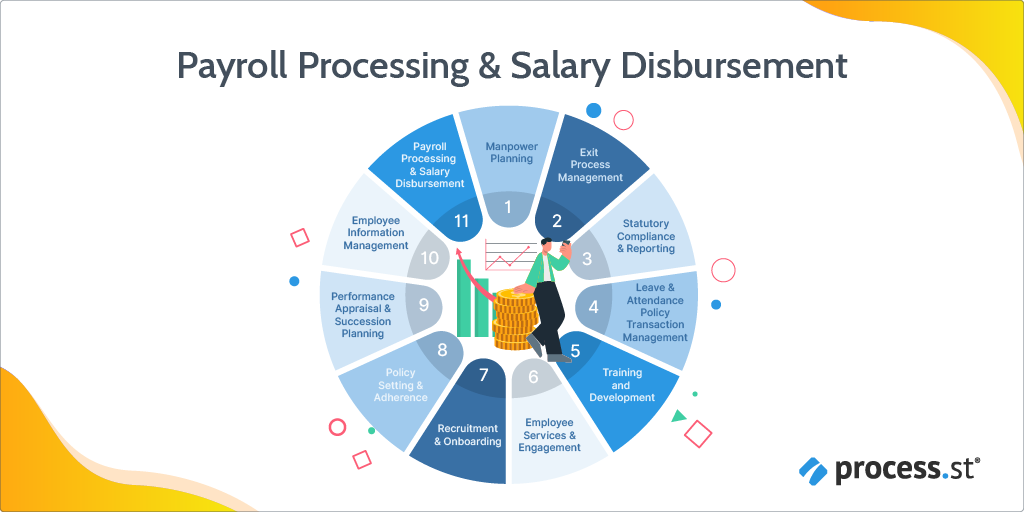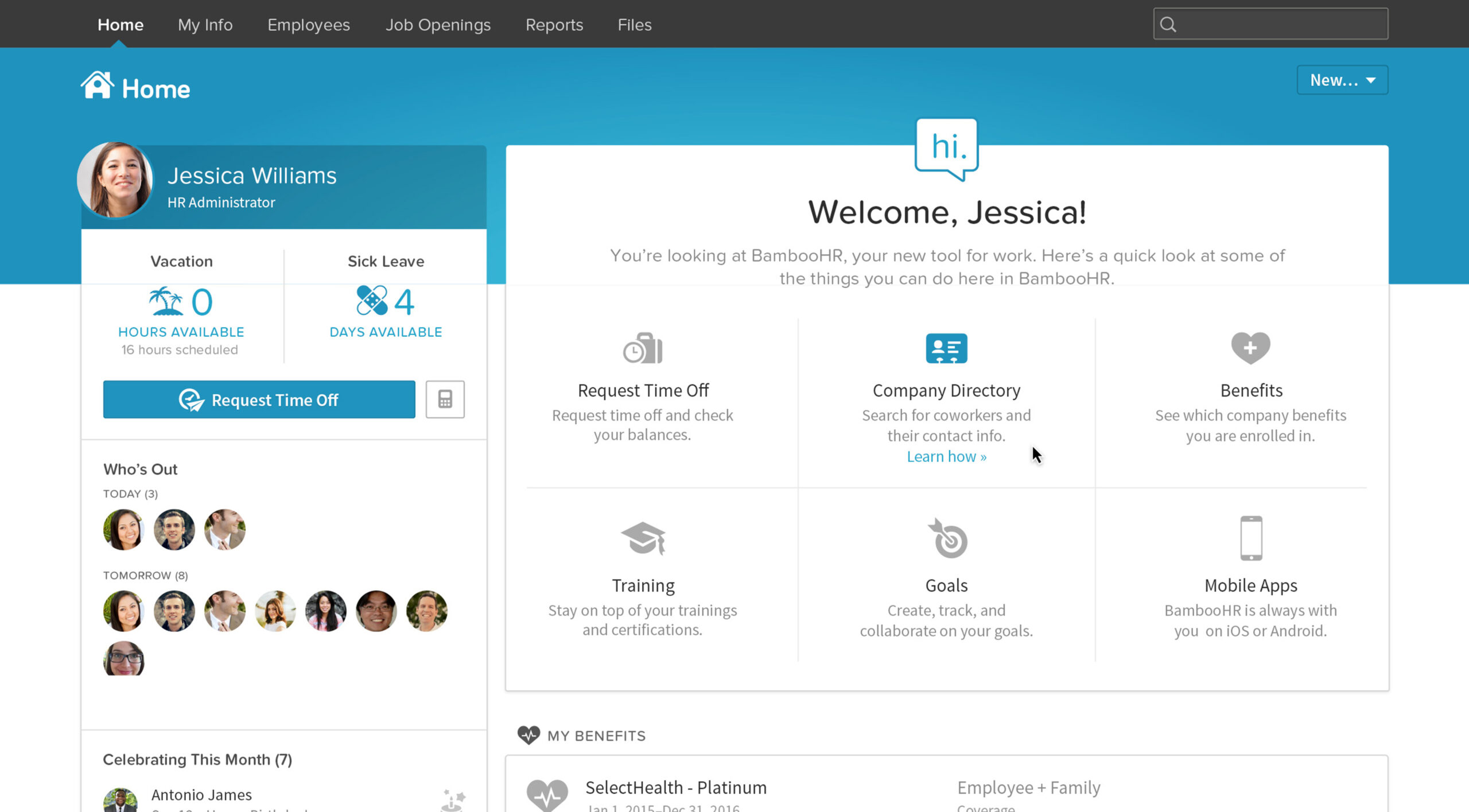
Scaling a business requires a joint effort between many stakeholders.
This necessity for effective teamwork means that companies need to put the right people in the right positions.
Human resources departments need to have effective systems in place to execute core HR functions – especially in recruitment and onboarding.
In this post for Process Street, we’re going to take a close look at how human resource management systems (HRMS) work and how they can give your company a leading edge in the war for talent.
- What is HRMS?
- 5 essential benefits of HRMS
- Challenges of integrating an HRMS
- How to get started with an HRMS
- Integrating your HRMS with simple workflow software
What is HRMS?
An HRMS (Human Resource Management System) is an all-in-one, centralized type of HR software that enables the management of several HR functions.
“The competitive edge modern business demands mean every procedure and process needs to get it right the first time – and for far less than it cost in the past. This […] can only be achieved through software systems whose intelligent implementation leads […] to a digitalization of the […] traditional HR department.”
– Orange HRM, The Importance of an HRMS to Any Company
Ultimately, the aim of an HRMS is to improve the productivity and efficiency of a business through efficient management of HR processes, primarily by consolidating data and automating manual and repetitive tasks.

An HRMS offers a simple way to integrate all of the core and strategic HR functions into one solution. The most common HRMS modules are:
- Recruiting and onboarding
- Payroll management
- Scheduling and time management
- Monitoring employee performance
- Reporting and analysis of workforce data
5 essential benefits of HRMS
Let’s dive into some of the most important benefits of integrating an HRMS solution.
Keep in mind that each benefit can be broken up into additional, more specific benefits. The capabilities of an HRMS stretch so far that the impact it can have on your organization is incredibly broad.
1. Improves the efficiency of core HR processes
For example, by standardizing processes related to employee information an HRMS eliminates repetitive tasks, reduces human error, and increases inter-departmental transparency.
In essence, it is the tremendous improvement in data management that enables the optimization of HR processes.
2. Enables a high degree of employee self-service
This is the ultimate win-win benefit of adopting an HRMS solution. It simultaneously frees up your HR manager’s time to focus on critical tasks and forward strategic goals, while also improving employee engagement and satisfaction. Considering that 87% of highly engaged employees are more like to stay with their current company, keeping job satisfaction up is an obvious priority.
Studies have found that 90% of leaders think an engagement strategy would have a notable impact on business success but barely 25% of them actually have a strategy.
While it isn’t an engagement strategy on its own, an HRMS gives employees more autonomy, which is a huge factor in engagement.
For example, using an HRMS, an employee can check their available time off, attendance and performance, or ability to work remotely without needing HR directly.

Don’t be fooled, however. Adopting an HRMS with excellent self-service functionality is only one side of the coin. You actually need to get your employees to use it before any benefits are noticed.
“Just to state the obvious: Buying the right system is only part of the battle. The key to getting the most from your self-service is an installation and implementation process that sets you up for success.”
– Dave Foxall, 6 Steps to HRMS Self-service Implementation Success
I snapped up the above quote from a great article by Dave Foxall where he breaks down 6 practical steps for successfully implementing HRMS self-service. I’d highly recommend having a read-through if you are looking to improve employee engagement with an HRMS.
3. Fast and easy reporting
Real-time data paired with powerful filters and visual representations allow managers to generate the reports they need when they need them.
A “big-picture” view of critical information can also be easily accessed and reviewed on a single screen with detailed dashboards.
With these reports, managers have greater insight when making decisions and can then take the most effective action to prevent inefficiencies.
For example, an HRMS monitors how long every employee remains in the same position. To prevent an employee from being stuck in a role they’re unsatisfied with, the HRMS will remind managers when it’s time to consider promotion.
4. Data centralization & security
Employee data is arguably the most sensitive and important data held by any organization.
Before HRM software, the method of storing and managing this data was, you guessed it, paper-based, which then migrated to libraries of spreadsheets. This approach is fragmented, error-prone, and time-consuming to manage.
An HRMS solution provides a cutting-edge level of security for all employee data, maintained within robust software that is incredibly difficult to penetrate and provides an easy way for managers to store and review data.
The centralization of data is also incredibly beneficial in terms of scalability because as the company grows and the headcount increases, there is minimal risk of losing sight of information concerning new employees.
5. Compliance with labor laws
There is a wide range of labor laws, tax codes, and other regulations that HR needs to keep a close eye on.
HRMS solutions typically keep track of changing regulations, notify managers to make sure they are complying with the latest regulations, and update the system to reflect these changes.

Challenges of integrating an HRMS
Before choosing an HRMS, HR and senior management need to determine what goals they hope to achieve.
Is the focus on improving the recruiting and onboarding process? Is it on establishing a way to centralize data and track employee performance?
In order to choose the right HRMS for your company, you’ll need to outline exactly what you what to get out of the software. Then you can work with the vendor to optimize the software for your goals.
Most vendors offer a high level of customization with varying price points, so it’s really up to you to make the best decision for your company.
For example, you may already have a payroll solution in place that works but would like an HRMS solution for talent management.
List what goals you want the software to meet and what modules you are looking for.
This will put you in a prime position to make a well-informed decision when selecting an HRMS.
How to get started with an HRMS solution

So then, we’ve gone through what HRMS is, how it can benefit your organization, and a few of the main challenges you can expect to face when integrating the software.
Now let’s look at some of the most important steps to getting started.
- Involve key stakeholders from the get-go;
- Consider hiring an HRMS consultant;
- Work closely with the IT department to migrate data;
- Conduct thorough testing to ensure all modules are working properly;
- Begin user training.
Involve key stakeholders from the get-go
Getting key stakeholders on board is a must if the implementation is going to be successful.
Leadership will be looking for a clear return on their investment with reports and analytics that show the impact of the HRMS.
Consider hiring an HRMS consultant
Hiring a specialist HRMS consultant can be a good idea if your HRMS integration will be complex or your company doesn’t have the appropriate expertise.
A consultant isn’t necessary for the system to be successful, but a quick cost-benefit analysis can help you figure out whether or not it’s a smart move for your company.
Work closely with the IT department to migrate data
The process of migrating data is complicated, sensitive, and requires a certain level of expertise. Working closely with the IT department by delegating and closely monitoring progress is a critical component of HRMS integration.
It’s also worth asking users to personally check that their own information is correct. While this maintains data integration, it also provides an opportunity to engage employees with self-service functionality.
Conduct thorough testing to ensure all modules are working properly before implementing the software across the whole organization.
Begin user training
The system is in place. Everything is working as it should be. Now it’s time to train users and get them comfortable with using the software.
Ideally, training should have a personalized and team component.
Hold a number of team meetings over the course of a few weeks to demo usage of the software for various roles (employees, managers, executives). Include and have in-depth Q&A sessions to answer any questions employees may have. Doing so will make them more inclined to use the product as they are expected to, increase accountability, and enable HR managers to do their jobs more effectively.
Personal training and coaching should be conducted for employees that are having trouble getting used to the software.
Integrating your HRMS with simple workflow software
By pairing your HRMS with simple workflow management software (like Process Street), you can establish a comprehensive way to document processes, assign specific tasks to users, and track progress in real-time.
The point is to minimize human error, increase accountability, and provide employees with all of the tools and information necessary to complete their tasks as effectively as possible.
Helping HR departments streamline processes is a big focus area for us. We’ve created a range of HR process templates that you can use for free.
These cover common processes such as employee onboarding (and the recruitment process in general). You can either use them as they are or customize them for your specific needs.
Through Process Street’s first-party Automations, you can connect your workflows to DocuSign, SalesForce, Slack, and many others. Zapier integrations also offer the opportunity to connect with over 2000 additional apps!
What kind of results are you and your team seeing from implementing an HRMS? Let me know in the comments below, I’d love to hear your thoughts!







 Workflows
Workflows Projects
Projects Data Sets
Data Sets Forms
Forms Pages
Pages Automations
Automations Analytics
Analytics Apps
Apps Integrations
Integrations
 Property management
Property management
 Human resources
Human resources
 Customer management
Customer management
 Information technology
Information technology



Alex Gallia
Alex is a content writer at Process Street who enjoys traveling, reading, meditating, and is almost always listening to jazz or techno. You can find him on LinkedIn here